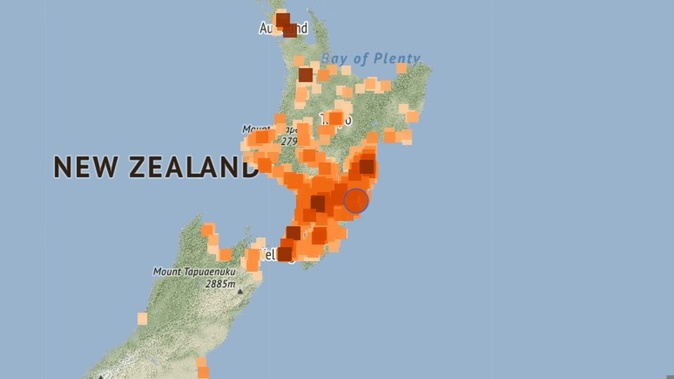
A flurry of strong earthquakes rocked the North Island this morning, causing damage in Hawke’s Bay. Civil Defence has confirmed there is no tsunami threat.
The first quake, magnitude 5.9, hit at 10.16am and was centred at Pōrangahau in Hawke’s Bay, Geonet said the tremor was 24 km deep.
A second quake, magnitude 5.4, hit three minutes later in the same area at 17km deep. Both quakes have been regarded as severe.
At 10.21am a third quake hit in the same area measuring magnitude 3.9. The third tremor was at a shallower depth of 14 km and centred 10 km west of Pōrangahau.
Geonet has recorded 41 quakes in the three hours since the severe 5.9 jolt struck at 10.16am.
New Zealand Civil Defence confirmed the quakes had not sparked a dangerous tidal wave across the eastern coastline.
A spokesperson for Fire and Emergency Central said the team had not responded to any incidents related to the earthquakes, while a police spokesperson said they have not been alerted to anything of note.
While a tsunami threat has been ruled out, a National Emergency Management Agency spokesperson said it was important that if people lived in a tsunami risk zone and felt an earthquake that was long or strong, get gone.
He said long was best defined as anything over one minute and strong as if you could not stand. He said you do not need to wait for an official evacuation warning.
‘It’s all damaged. Everything is on the ground’
One Pōrangahau resident said the area had been “smashed by the biggest earthquake”.
”S*** flying everywhere out of cupboards and shelves, a second one just starting out house is rocking uncontrollably.”
“We are getting in our car, too dangerous in the house the shakes are continuing,” a Pōrangahau resident said on Facebook.
A staff member at the Duke Hotel in Pōrangahau was in the upstairs office when the whole building shook from side to side.
“It’s all damaged. Everything is on the ground.
“We are just on the phones at the moment trying to find out if we have to evacuate, questions about the tsunami are definitely rising.”
Robert Houkamau, whose father owns the Duke Hotel in Pōrangahau, said it was a severe shake.
”It was pretty intense. I don’t really know how to describe it. It was the biggest earthquake I’ve ever felt.”
/cloudfront-ap-southeast-2.images.arcpublishing.com/nzme/2C3FUI2CE5GLBNTX5AC5YTVYX4.jpg)
Damage in the fridge and office at The Duke, Porangahau. Photo / Robert Houkamau
He said the initial quake lasted about 30 seconds followed by aftershocks lasting up to 90 seconds.
Staff were assessing the damage.
”The single bottles in the chiller have been thrown around. Bottles have been broken and some have fallen over.”
He said the earthquake was a “little bit concerning” because of the township’s proximity to the coastline about 1.3km away and the possibility of a tsunami.
The hotel’s manager said the neighbours had lost their television and sustained smashed windows as a result of the shake.
“No one is injured that we know of. The fire service is currently checking. We have only lost stock.”
Once the shaking stopped Houkamau evacuated to the Pōrangahau Hall. He said “I just thought...what’s going to happen next? We’ve just been through a cyclone and flooding, now an earthquake, we don’t want a tsunami. We don’t want any more disasters.”
A Napier resident has reported the rolling sensation was so long it made them feel nauseous.
Peggy Scott, who lives on the whenua of the Longest Place Name in the World a few minutes away from Pōrangahau, said the two successive shakes were very scary.
”We definitely felt it. We live rurally on Wimbledon Rd, and things had started to come off of shelves, it made a bit of a mess, we have just cleaned it up.
”We have packed bags with food and water in case we have to go up the hill. My parents who are down in the village have said there has been a mess there as well.
”We don’t feel like it’s over. Everyone is just preparing.”
Angela MacGregor, a worker at the Bottle-O in Mangatera in Dannevirke, told Hawke’s Bay Today the lights were swinging inside the store but fortunately nothing smashed or fell off the shelves.
She said it went for a matter of minutes and stopped at one stage before starting again.
“I thought ‘please don’t be a big one’.”
Porangahau School students were evacuated to the Porangahau Hall, as the school sits near the border of the tsunami zone.
Principal Julie Scandrett said the children followed the often-practiced earthquake drill of “drop, cover and hold” then once the shaking stopped calmly evacuated to the hall where they waited for Civil Defence to give the all clear.
“We practice drills and evacuations regularly so when it’s the real thing the staff and children all know what to do, and it went very smoothly. We let whanau know, via our Facebook page, that we had evacuated. The Ministry of Education were in touch straight away, and we will do a property assessment today to assure everything is safe.”
A Puketauhinu Pl resident who lives near the beach told the Herald her children who study at Pōrangahau School have been evacuated to the village hall.
”It was quite rolly and deep shake. We are still waiting for any official communication. I have heard no siren and no alerts from civil defence yet.
”We just don’t know what to do. One of my family members is going to get the kids from the village hall where they have been evacuated from the school.”
Items flying off shelves
The mayor of central Hawke’s Bay Alex Walker said the Pōrangahau area was already hard hit by Cyclone Gabrielle and people were already “pretty shaken up”.
”This morning has shaken them further,” she told NZME.
”Properties have been shaken about, belongings [have been] shaken about...people are worried.”
A Beach Rd, Pōrangahau resident told the Herald the shake was severe and frightening.
”We had two shakes, a lot of rolling. Crockery items, glassware and food has come off shelves, but we have cleaned it up.
“The school was evacuated but has been told no tsunami threat so students and staff are returning.
”I live right at the beach and I can’t see any rougher seas than what is normal.”
Napier resident Michelle Fox told the Herald her husband and son who were at their Latham St home described the shake as “bumping up and down and then a huge jolt”.
“Kindy is liaising with Marewa School and preparing to evacuate if it comes to that.”
Felt by at least 50,000 people
The shakes have been felt widely across the lower North Island with people in Wellington reporting a rolling motion.
In Napier, office employees hid under desks as the quake rolled for roughly a minute.
About 50,000 people throughout the country have recorded feeling the four earthquakes, according to GeoNet.
“I have never felt such huge shakes,” a Porangahau local wrote online.
“I thought our old house was going to fall down, they are still going.”
Geonet said there has been severe shaking in Porangahau this morning with a M5.9 tremor followed closely by a M5.4.
“Our team are still looking at this so the size/locations are currently preliminary. We will have updated information ASAP,” it posted on Facebook.
A homeowner on the Kapiti Coast said he felt a “rolling, rocky roll” which lasted about 30 seconds.
“It wasn’t a big shake, just a rolling motion.”
The man’s house is on the Raumati South beachfront, but he was not concerned about any potential tsunami and didn’t plan to move to higher ground.
“I don’t think any tsunami is going to reach us here because we’re 10m above the mean high tide level.”
‘Some of the larger we’ve seen in the last 10 years or so’
GNS Science geophysicist Dr Laura Wallace said the quakes occurred in a region that “experiences seismicity relatively frequently”.
”In the past, we have frequently seen swarms of moderate to large earthquakes there, but the two events today were some of the larger ones we’ve seen in the last 10 years or so.”
The region sat near the boundary of the Pacific and Australian plates – where the former dived under the other, westward beneath the North Island, to create the Hikurangi Subduction Zone.
It also happened to be a hot spot for slow-motion earthquakes called “slow-slip events”, which could released pent-up energy over weeks, months and years. These tended to happen within areas where the subduction zone was transitioning from being “stuck” beneath the southern North Island, to an area where the subduction zone was “creeping” further north, around Gisborne and Hawke’s Bay.
One such event – linked to a 6.3 quake in Kapiti in February – was still going deep beneath the Manawatu and Horowhenua regions, and Wallace suspected today’s shakes were also connected to the process.
”Sometimes we can get earthquakes like this when we’re not having slow slip, but I’d think that there is a reasonably high likelihood that this could be related to the Manawatu slip event that’s ongoing,” she said.
”It’s not very far from that area and we do tend to see swarms of earthquakes like this during those Manawatu slow-slip events.”
Take your Radio, Podcasts and Music with you









